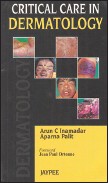Translate this page into:
Critical Care in Dermatology
Correspondence Address:
Kaushal K Verma
Department of Dermatology and Venereology, All India Institute of Medical Sciences, New Delhi - 110 029
India
| How to cite this article: Verma KK. Critical Care in Dermatology. Indian J Dermatol Venereol Leprol 2013;79:851 |
 Editiors: Arun C Inamadar and Aparna Palit
Editiors: Arun C Inamadar and Aparna Palit
Publisher: New Delhi: Jaypee Brother Medical Publishers (P) Ltd, India
ISBN 978-81-924968-0-1
Edition: First 2013
Pages: 259
ISBN 978-93-5090-285-1
INR 795/-
The book ′′Critical Care in Dermatology′′ by Inamadar and Palit is a valuable addition in critical care practice of Dermatology as an easy and handy document. It has a good description of common, uncommon, and rare dermatological emergencies which Dermatologists encounter in their clinical practice. There is a detailed description of each dermatological emergency: how to recognize it; how to assess the severity and details of management. It also gives a good overview of general measures in the management of these emergent situations, which are of critical importance. There is a full chapter dedicated to Fluid, Electrolyte and Nutrition Therapy which is often a challenge for Dermatologists, since many are not familiar with the finer details of these therapies and the detail of the monitoring techniques and procedures during the management of these emergencies. The book also describes sample collection methods from different sites in critically ill patients for appropriate diagnosis and management. The issue of nursing care in Dermatological emergencies, which is an over-sighted aspect in the management of such emergent situations, has been well emphasized and appropriately detailed. The concept of Dermatological Intensive Care Unit is well highlighted in the book with details of necessary equipments needed for such set-up. A dedicated chapter on the Drugs used in Dermatological Emergencies would also be handy for treating physicians, to critically review the different aspects of the drugs including doses, adverse effects, drug interactions etc., Authors have also included a chapter on Drug Therapy in patients with renal and hepatic impairment which may at times be the situations in these patients. A chapter on Drugs in Pregnancy and Lactation appears to be an unnecessary avoidable intrusion in the book. More appropriate would have been the inclusion of management of Dermatological Emergencies in Pregnant and Lactating women which may at times be complex and challenging. At places in the texts, the sentences are incomplete, lack systematic presentation, and flow. The text matter at places is disjointed. Also there is repetition of texts at different places which could have been avoided. The skin biopsy has often been mentioned as a rapid diagnostic technique which at many centers is often not available for such purpose and there are no histopathological details of the various conditions where biopsy has been recommended or mentioned, to be of help to diagnosis the condition. At places, the tables are appearing before the text which makes reading of the book uneasy. Sometimes, tables appear at different places then the texts, leaving the readers wonders as to why these could not have been placed close to the text. ′′Why a particular condition is an emergency′′ good for the beginners to recognize condition as an emergency and manage it appropriately.
Overall, the book may be of value to Dermatologists working in a hospital setting and for trainees. Reducing the number of tiny illustrations on the front page, avoiding shades of color on the top of each page and slightly larger font-size of the text could have made the book more reader friendly.
Fulltext Views
2,949
PDF downloads
2,295





